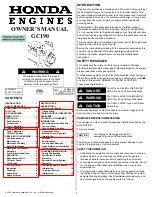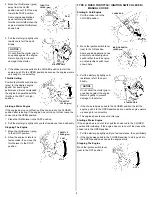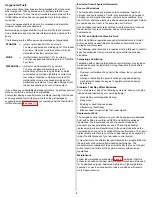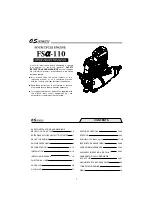
4
TYPE 3: FIXED THROTTLE / ENGINE STOP SWITCH /
MANUAL CHOKE
Starting A Cold Engine
1. Pull the choke rod to the
CLOSED position.
2. Move the engine stop switch
to the ON position.
Some engine applications
use a remotely-mounted
ignition switch rather than the
engine-mounted engine stop
switch shown here.
3. Pull the starter grip lightly until
resistance is felt, then pull
briskly.
NOTICE
Do not allow the starter grip to
snap back against the engine.
Return it gently to prevent
damage to the starter.
4. If the choke rod was pulled to
the CLOSED position to start
the engine, push it to the OPEN
position as soon as the engine
warms up enough to run
smoothly.
5. The engine speed is preset on this type.
Starting a Warm Engine
If the engine has run out of fuel, pull the choke rod to the CLOSED
position after refueling. If the engine has not run out of fuel, leave the
choke rod in the OPEN position.
1. Pull the starter grip lightly until you feel resistance, then pull briskly.
2. If the choke was pulled to the CLOSED position to start, push it to
the OPEN position as soon as the engine starts.
Stopping The Engine
Move the engine stop switch to the OFF position.
OIL ALERT
®
SYSTEM
The Oil Alert system is designed to prevent engine damage caused by
an insufficient amount of oil in the crankcase. Before the oil level in the
crankcase can fall below a safe limit, the Oil Alert system will
automatically stop the engine [the throttle lever (ignition switch lever)
will remain in a run position].
If the engine stops and will not restart, check the engine oil level
(page 5) before troubleshooting in other areas.
SERVICING YOUR ENGINE
THE IMPORTANCE OF MAINTENANCE
Good maintenance is essential for safe, economical and trouble-free
operation. It will also help reduce pollution.
To help you properly care for your engine, the following pages include
a maintenance schedule, routine inspection procedures, and simple
maintenance procedures using basic hand tools. Other service tasks
that are more difficult, or require special tools, are best handled by
professionals and are normally performed by a Honda technician or
other qualified mechanic.
The maintenance schedule applies to normal operating conditions. If
you operate your engine under severe conditions, such as sustained
high-load or high-temperature operation, or use in unusually wet or
dusty conditions, consult your servicing dealer for recommendations
applicable to your individual needs and use.
Maintenance, replacement, or repair of the emission control
devices and systems may be performed by any engine repair
establishment or individual, using parts that are “certified” to
EPA standards.
MAINTENANCE SAFETY
Some of the most important safety precautions follow. However, we
cannot warn you of every conceivable hazard that can arise in
performing maintenance. Only you can decide whether or not you
should perform a given task.
SAFETY PRECAUTIONS
• Make sure the engine is off before you begin any maintenance or
repairs. This will eliminate several potential hazards:
–
Carbon monoxide poisoning from engine exhaust
.
Be sure there is adequate ventilation whenever you operate
the engine.
–
Burns from hot parts
.
Let the engine and exhaust system cool before touching.
–
Injury from moving parts
.
Do not run the engine unless instructed to do so.
• Read the instructions before you begin, and make sure you have
the tools and skills required.
• To reduce the possibility of fire or explosion, be careful when
working around gasoline. Use only a nonflammable solvent, not
gasoline, to clean parts. Keep cigarettes, sparks and flames away
from all fuel related parts.
Remember that an authorized Honda servicing dealer knows your
engine best and is fully equipped to maintain and repair it.
To ensure the best quality and reliability, use only new genuine Honda
parts or their equivalents for repair and replacement.
CHOKE ROD
ON
ENGINE
STOP
SWITCH
OFF
STARTER GRIP
WARNING
Improper maintenance, or failure to correct a problem
before operation, can cause a malfunction in which you
can be seriously hurt or killed.
Always follow the inspection and maintenance
recommendations and schedules in this owner’s manual.
WARNING
Failure to properly follow maintenance instructions and
precautions can cause you to be seriously hurt or killed.
Always follow the procedures and precautions in this
owner’s manual.


































